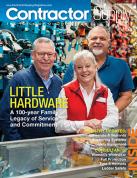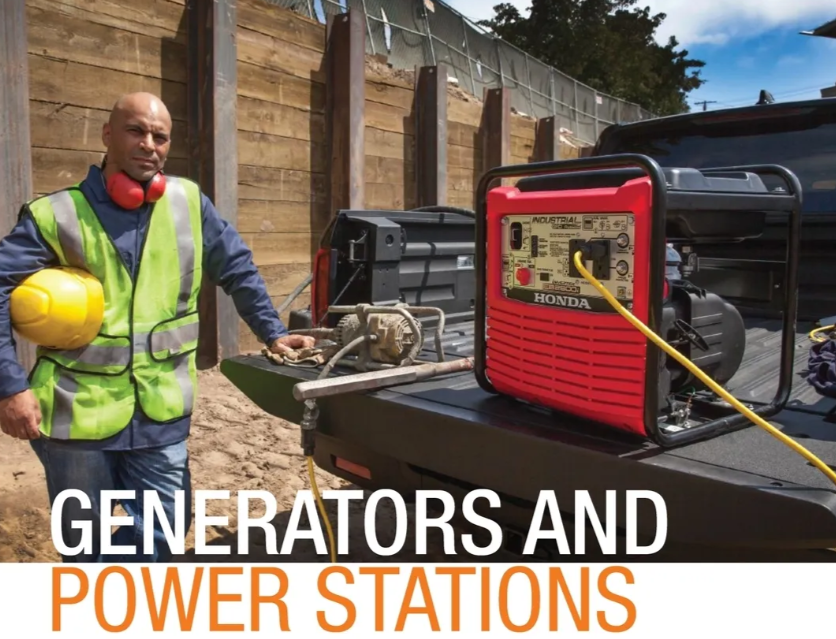 |
Power to the People Wherever They Work
Today’s generators and power solutions offer users their choice of inverter, gas, diesel or battery-bank power for greater jobsite mobility. These innovative manufacturers are expanding the range of power products and their applications.
HONDA
While global markets remain volatile and specific forecasting more uncertain, Honda Power Sports & Products retains a positive overall outlook for the general construction industry, the continued evolution of its product portfolio, and the tool distribution industry.
As a business unit of American Honda Motor Co., it markets a complete range of outdoor power equipment, including generators, walk-behind lawn mowers, pumps, snow blowers, tillers, string trimmers, outboard marine engines, and small, general-purpose engines for residential, commercial, and rental applications.
“The broadest misconception is that while Honda is working to bring battery-electric to its product lineups, some people in the industry assume that the company is abandoning gas-powered products altogether, which is not the case,” says Barry Dlugasz, director, Honda power equipment sales, American Honda Motor Company Inc. “The Honda Power Sports & Products focus is to drive development of new products, new technologies, and a diversified power portfolio, offering a leading premium power equipment/lifestyle brand that is environmentally responsible, reliable, convenient, quiet and high performing.”
He says the company remains committed to the environment and innovation, allocating resources to advance both internal combustion engines (ICE) and battery-electric (BE) technologies.
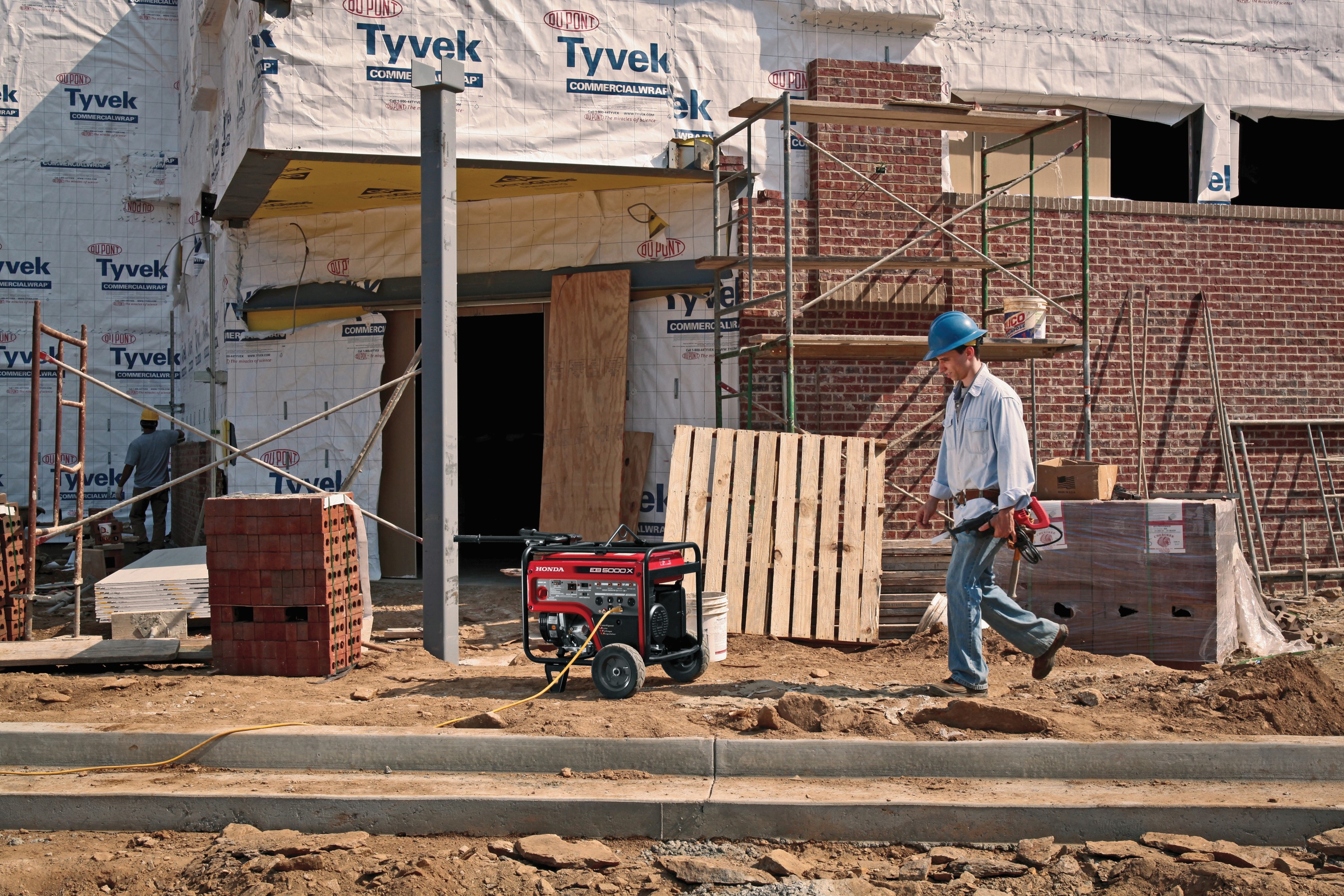 |
| Honda generators for commercial applications produce between 1,000 and 10,000 watts of power, providing dependable power for construction jobsites. |
“We recognize that electrification will play a growing role in the industry and continue to evolve offerings accordingly,” Dlugasz says. “At the same time, Honda remains deeply invested in internal combustion engines, providing durable, efficient, and high-performance engines that serve a wide range of professional applications.”
Additionally, he emphasized that with its ongoing support of professionals of reliable power solutions, Honda understands the industry and product trends for generators used in the commercial space are directly connected to the engines and technology powering those products.
Lightweight, compact Honda generators for commercial and consumer applications produce between 1,000 and 10,000 watts of power, providing smooth, dependable power for recreation, construction, rental, computers, appliances, and emergency use.
He says all Honda generators are powered by advanced Honda 4-stroke engines and incorporate technology that make Honda generators among the world’s quietest. Honda generators for typical residential use average 64 to 73 decibels, with the Super Quiet Series operating at noise levels as low as 49 decibels, roughly the noise level in a private office. Models also carry the Honda industry-competitive, commercial-use, three-year warranty.
At World of Concrete 2025, Honda introduced its iGX design concept incorporating two all-new engines, the Honda iGX400 and the Honda iGX430, gas-powered models that offer commercial construction customers a new level of performance, value, and versatility in a compact package. The new models feature smart fuel injection technology that eliminates engine choke and an integrated self-tuning regulator governor to assist in management of engine operations in demanding commercial environments.
“With generators, the trend toward fuel injection points to one of the primary maintenance challenges concerning carburetor-related issues, especially due to the quality of today’s fuel and equipment storage patterns,” he says. “To address this, Honda has increasingly implemented fuel injection technology across its power product lines.”
Also, in April 2025, Honda’s EU3200i and EU7000iS Super Quiet Series generators went on sale in California, having met both U.S. Environmental Protection Agency Phase 3 emissions standards and California Air Resources Board Tier 4 compliance requirements.
Dlugasz says the Honda Super Quiet Series generators are inverter technology-equipped, lightweight models that feature an enclosed body and significant acoustic engineering, resulting in noticeably quieter performance for a range of recreational, commercial, and home backup power applications. They also feature Honda’s Eco Throttle system which maximizes efficiency by adjusting output to load requirements.
According to Dlugasz, generators featuring inverter technology process the raw power produced by the generator and pass it through a special microprocessor to produce the most stable power.
“This means sensitive equipment can operate from a remote location with a reduced possibility of interrupted service or damage to the equipment, which is particularly important on jobsites where more and more contractors rely on sophisticated equipment that must be charged and recharged,” he says.
To meet compliance standards, Honda incorporated several design enhancements into the EU3200i and EU7000iS Super Quiet generators, including an evaporative emission control (EVAP) system, fuel cap tether, and improved canister working capacity, which, work together to optimize fuel combustion and further lower air emissions of nitrogen oxides, particulate matter, hydrocarbons, and sulfur.
Dlugasz notes that Honda was the first in the industry to commit to installing CO detection systems on its full line of generators, and in 2020, Honda became the first generator manufacturer to equip all models in its portable generator lineup with CO-MINDER, its advanced carbon monoxide (CO) detection system.
Steps are being taken in 2025 toward additional generator safety by equipping portable generators with an advanced version of its original CO-MINDER™ carbon monoxide (CO) detection and automatic shutoff system. All Honda generators across the Economy, Deluxe, Industrial and Super Quiet Series now integrate CO-MINDER enhancements, meaning all models meet ANSI/PGMA G300-2023 safety and performance standards.
“Overall, Honda seeks to realize a society with zero environmental impact, establishing the Triple ZERO initiative which integrates carbon neutrality, clean energy and resource circulation, net zero by 2050,” Dlugasz says. “Today, in providing both internal combustion engines and battery-powered motor and generators, Honda is giving users the opportunity to use the best source of power for their individual needs.”
He says that though electric is a growing trend, smaller general purpose gas-powered engines are still a major part of power equipment design, production, and use. Commercial users prioritize reliability and runtime, and currently, internal combustion engines are often the most practical solution for many applications including generators.
ECHO
ECHO Incorporated sees a strong and sustained outlook for mobile power solutions across a wide range of sectors from construction and data centers to disaster relief and live events.
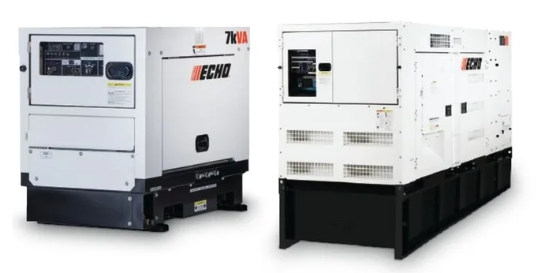 |
| With generator models ranging from the compact DGK7F (7kVA) to the highcapacity DGK180F/P (180kVA), ECHO offers scalable, dependable performance in a variety of sizes. |
Ryan Fredrickson, product marketing manager for ECHO, notes that in construction alone, the equipment rental market is projected to grow at around a 5% CAGR through 2029, signaling steady demand.
“Within that demand, the need is not just for power, but for reliable power that keeps operations running,” he says. “Downtime can cost commercial and industrial businesses thousands and sometimes millions of dollars, so having durable, dependable equipment is critical.”
Also, Fredrickson cites the growing number of weather or climate-related disaster in the U.S. as another factor in the growing demand for backup power in emergencies.
“Customers want equipment they can count on in any conditions,” he says. “At the same time, there’s growing interest in quieter, more fuel-efficient machines that help reduce operating costs and meet stringent emissions standards.”
Another key trend that is impacting design of power solutions is the shrinking pool of skilled operators across construction, mining, oil and gas and other sectors.
“Equipment must be able to be managed and maintained easily, even by first-time users,” Fredrickson says.
Combined, these factors give him confidence in the continued growth and importance of the mobile power sector. Labor shortage and natural disasters are driving innovation across the industry, shaping how power solutions are designed and delivered to customers both now and in the future.
Manufacturers, distributors and rental companies are adapting to the economic unpredictably by strengthening their supply chain resilience.
“In today’s economic climate, companies across construction, energy, and industrial sectors are focused on cost control and capital preservation, leading to more customers choosing to rent equipment rather than commit to large capital purchases,” Fredrickson says. “This shift puts extra emphasis on fleet reliability and equipment availability.”
For some, that means reshoring more component sourcing and assembly to the U.S.
“At ECHO, we’ve undergone a comprehensive evaluation of our supply chain and have taken actions to move more component content and assembly domestically with the goal of helping reduce lead times and give our partners dependable access to the power solutions they need, when they need them,” he says.
A common misconception is how to properly size prime power solutions for an application. Fredrickson notes that many users tend to oversize equipment “just in case,” but this often leads to unnecessary fuel consumption and potential reliability issues.
“This challenge has grown as powered equipment has become more energy efficient, for example, a machine that once required a 45 kVA generator may now run perfectly on a 25 kVA unit,” he says
ECHO’s product manager says he is excited about the ongoing advancements in cleaner energy technologies.
“This includes innovations in alternative fuels and energy storage solutions that help reduce emissions and noise without compromising reliability,” Fredrickson says. “This technology allows us to develop power solutions that perform consistently in extreme climates and demanding work environments, while supporting our customers’ sustainability goals and regulatory requirements.”
Beyond cleaner and more efficient, the other priorities cited by customers are safety, time and cost. Fredrickson says ECHO’s short-term strategic priorities focus on three clear commitments: simplifying and speeding up power deployment, providing greater versatility, and delivering industry-leading customer support.
“First, we’re focused on making our equipment intuitive and easy to use,” he says. “Many end users aren’t technical experts, so setup and maintenance need to be straightforward. Our generators are engineered with clear interfaces, on-unit instructions, and accessible components that minimize user error and keep projects on schedule.”
Second, Fredrickson says ECHO is prioritizing versatility and scalability to meet diverse jobsite needs.
“Our proprietary Simul-Phase technology allows customers to draw both single-phase and three-phase power simultaneously from a single generator, eliminating the need for external transformers and simplifying logistics, which saves time and cost,” he says.
Lastly, the company remains committed to providing quality customer service, responding to needs of distributors and rental companies with responsive service, on-site and virtual training and fast turn around parts and support.
“Looking ahead, we’re also expanding our product portfolio with higher kW units and deepening our investment in domestic assembly and R&D for faster delivery, consistent quality, and continued innovation tailored to the North American market,” Fredrickson says.
BOBCAT
Like other manufacturers, Bobcat has a positive outlook for the portable power industry.
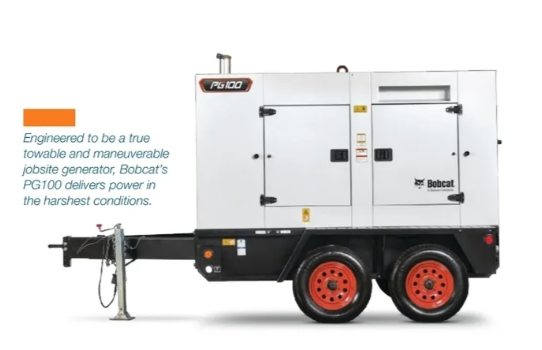 |
“We’re seeing sustained reliance on the multifunctionality and reliability of portable generators across a wide array of vital sectors,” says Erin Brown, product manager at Bobcat. “From powering essential tools on dynamic construction sites to maintaining critical operations in disaster relief, telecommunications, and even special events, portable power is more indispensable than ever.”
Portable generators deliver next-level stability, providing crucial power in diverse and demanding environments. Brown notes for example, that they’re indispensable on construction sites, providing essential energy for tools and equipment where grid access is limited or unavailable. Their portability allows for easy relocation as projects evolve, while their robust performance in challenging conditions ensures uninterrupted operations, boosting productivity.
“Similarly, these generators are crucial for delivering essential power during disaster relief efforts ensuring continuity in telecommunications networks, and maintaining life-saving operations in healthcare facilities,” Brown says. “The criticality and versatility of portable generators across countless jobsites firmly establish them as highly valued assets. This widespread reliance and their proven performance fuel our optimistic outlook for the industry’s continued growth and innovation.”
Brown says there is a common misconception that the portable generator market is smaller than it is.
“The reality is, it touches nearly every aspect of modern life,” she says. “Virtually every industry, every government institution, and especially every contractor service, needs dependable electricity at some point.”
From keeping remote job sites operational to ensuring critical infrastructure stays online, the demand for reliable power solutions is far more extensive than many people realize.
Facilities such as data centers, which handle everything from mobile phones to internet and telecommunications, constantly require power.
“This just highlights the constant, overarching need for robust and reliable power solutions that can go anywhere,” Brown says.
In addition to being a larger market than most perceive, Brown says it is also growing at a faster rate than many other business sectors.
“As our aging electrical grids face increasing strain, any reliable, decentralized power source is not just a nice-to-have, it’s a welcome and essential partner in keeping things running smoothly,” Brown notes.
Several significant trends are shaping the portable power industry right now. From an innovative standpoint, Brown says there is enhanced usability, multifunctionality with modern generators becoming more intuitive and offering both single-phase or three-phase outputs for diverse power needs.
“There’s a growing popularity of enclosed generators, which provide superior weather protection, noise reduction, and enhanced security, leading to extended durability,” she says.
Another key trend is an increased use of parallel generators to achieve higher power outputs, driven by the size limitations of Tier-4 Final (T4F) engines and also the need for proper generator sizing to avoid wet-stacking.
Lastly, Brown says the industry is witnessing the emergence of hybrid solutions that combine diesel engines with battery energy storage systems, offering long-term benefits despite higher initial costs.
“In today’s changing economic climate, it’s no surprise that contractors and operators are looking for ways to trim costs without negatively impacting their productivity,” Brown says. “Being able to utilize one portable generator for a variety of tasks will be key.”
For example, she says operators can select a portable generator with a flexible power output range and multiple outlets to accommodate different types of equipment, including those with varying voltage and current needs.
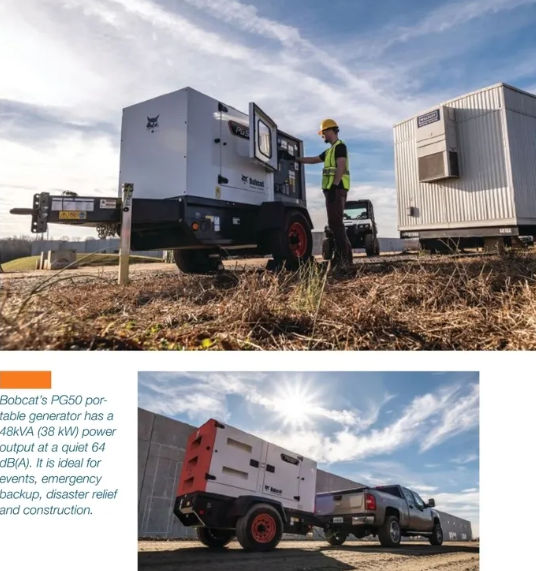 |
Additionally, Bobcat generators with parallel load management systems can help balance power distribution and prevent overload by only running the required number of generators to handle the connected load in a multi-generator configuration.
Features like digital displays for real-time monitoring of power usage and remaining runtime can also aid in power management. Ensuring the generator has sufficient capacity to handle both continuous and surge loads will further ensure reliable performance and prevent potential disruptions on the job site.
Brown says remote monitoring and telemetry are revolutionizing how Bobcat customers manage portable power fleets by providing anticipatory notices on unit operation.
“These innovations give them a heads-up on error codes before an engine shut down,” she says. “This translates directly into operational efficiencies.”
When a service technician arrives on site, knowing whether they’re tackling a fuel system fault, an electrical issue, or simply needing to top off a fuel or DEF tank, it saves valuable time and minimizes costly downtime.
Looking ahead, she says Bobcat envisions the possibility of Artificial Intelligence (AI) integration to further enhance remote diagnostics and optimize load management.
“Our ultimate goal is to maximize uptime, ensuring our customers’ projects and critical operations stay powered, reliably and efficiently, every single time,” Brown says.
Bobcat’s strategy remains centered around the idea of empowering its customers to accomplish more. Brown cites the company’s most popular portable generator models as examples, the Bobcat PG50 portable generator and the Bobcat PG100.
The PG50 is ideal for events, emergency backup, disaster relief and construction with a 48kVA (38 kW) power output at a quiet 64 dB(A).
“Its built-in safety measures and easy-to-read gauges make for safe and simple operation and includes thoughtfully positioned access doors to ensure easy job site servicing and routine maintenance,” she says, noting that it offers versatile power and long run times and its compact enclosure results in easy maneuverability.
Engineered to be a true towable and maneuverable jobsite generator, the PG100 delivers power in the harshest conditions. Brown says, it offers the quietest mid-range package in the market and comes with important safety precautions built in to protect the operator and machine.
LEARN MORE
www.echo-usa.com
www.bobcat.com
www.powerequipment.honda.com
This article originally appeared in the August/September 2025 issue of Contractor Supply magazine. Copyright, 2025 Direct Business Media.







